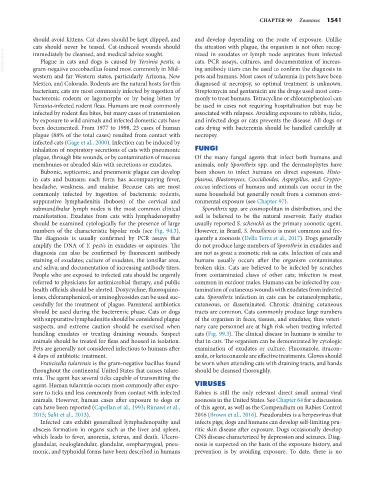Page 1569 - Small Animal Internal Medicine, 6th Edition
P. 1569
CHAPTER 99 Zoonoses 1541
should avoid kittens. Cat claws should be kept clipped, and and develop depending on the route of exposure. Unlike
cats should never be teased. Cat-induced wounds should the situation with plague, the organism is not often recog-
VetBooks.ir immediately be cleansed, and medical advice sought. nized in exudates or lymph node aspirates from infected
cats. PCR assays, cultures, and documentation of increas-
Plague in cats and dogs is caused by Yersinia pestis, a
gram-negative coccobacillus found most commonly in Mid-
pets and humans. Most cases of tularemia in pets have been
western and far Western states, particularly Arizona, New ing antibody titers can be used to confirm the diagnosis in
Mexico, and Colorado. Rodents are the natural hosts for this diagnosed at necropsy, so optimal treatment is unknown.
bacterium; cats are most commonly infected by ingestion of Streptomycin and gentamicin are the drugs used most com-
bacteremic rodents or lagomorphs or by being bitten by monly to treat humans. Tetracycline or chloramphenicol can
Yersinia-infected rodent fleas. Humans are most commonly be used in cases not requiring hospitalization but may be
infected by rodent flea bites, but many cases of transmission associated with relapses. Avoiding exposure to rabbits, ticks,
by exposure to wild animals and infected domestic cats have and infected dogs or cats prevents the disease. All dogs or
been documented. From 1977 to 1998, 23 cases of human cats dying with bacteremia should be handled carefully at
plague (88% of the total cases) resulted from contact with necropsy.
infected cats (Gage et al., 2000). Infection can be induced by
inhalation of respiratory secretions of cats with pneumonic FUNGI
plague, through bite wounds, or by contamination of mucous Of the many fungal agents that infect both humans and
membranes or abraded skin with secretions or exudates. animals, only Sporothrix spp. and the dermatophytes have
Bubonic, septicemic, and pneumonic plague can develop been shown to infect humans on direct exposure. Histo-
in cats and humans; each form has accompanying fever, plasma, Blastomyces, Coccidioides, Aspergillus, and Crypto-
headache, weakness, and malaise. Because cats are most coccus infections of humans and animals can occur in the
commonly infected by ingestion of bacteremic rodents, same household but generally result from a common envi-
suppurative lymphadenitis (buboes) of the cervical and ronmental exposure (see Chapter 97).
submandibular lymph nodes is the most common clinical Sporothrix spp. are cosmopolitan in distribution, and the
manifestation. Exudates from cats with lymphadenopathy soil is believed to be the natural reservoir. Early studies
should be examined cytologically for the presence of large usually reported S. schenckii as the primary zoonotic agent.
numbers of the characteristic bipolar rods (see Fig. 94.3). However, in Brazil, S. brasiliensis is most common and fre-
The diagnosis is usually confirmed by PCR assays that quently a zoonosis (Della Terra et al., 2017). Dogs generally
amplify the DNA of Y. pestis in exudates or aspirates. The do not produce large numbers of Sporothrix in exudates and
diagnosis can also be confirmed by fluorescent antibody are not as great a zoonotic risk as cats. Infection of cats and
staining of exudates; culture of exudates, the tonsillar area, humans usually occurs after the organism contaminates
and saliva; and documentation of increasing antibody titers. broken skin. Cats are believed to be infected by scratches
People who are exposed to infected cats should be urgently from contaminated claws of other cats; infection is most
referred to physicians for antimicrobial therapy, and public common in outdoor males. Humans can be infected by con-
health officials should be alerted. Doxycycline, fluoroquino- tamination of cutaneous wounds with exudates from infected
lones, chloramphenicol, or aminoglycosides can be used suc- cats. Sporothrix infection in cats can be cutaneolymphatic,
cessfully for the treatment of plague. Parenteral antibiotics cutaneous, or disseminated. Chronic draining cutaneous
should be used during the bacteremic phase. Cats or dogs tracts are common. Cats commonly produce large numbers
with suppurative lymphadenitis should be considered plague of the organism in feces, tissues, and exudates; thus veteri-
suspects, and extreme caution should be exercised when nary care personnel are at high risk when treating infected
handling exudates or treating draining wounds. Suspect cats (Fig. 99.3). The clinical disease in humans is similar to
animals should be treated for fleas and housed in isolation. that in cats. The organism can be demonstrated by cytologic
Pets are generally not considered infectious to humans after examination of exudates or culture. Fluconazole, itracon-
4 days of antibiotic treatment. azole, or ketoconazole are effective treatments. Gloves should
Francisella tularensis is the gram-negative bacillus found be worn when attending cats with draining tracts, and hands
throughout the continental United States that causes tulare- should be cleansed thoroughly.
mia. The agent has several ticks capable of transmitting the
agent. Human tularemia occurs most commonly after expo- VIRUSES
sure to ticks and less commonly from contact with infected Rabies is still the only relevant direct small animal viral
animals. However, human cases after exposure to dogs or zoonosis in the United States. See Chapter 64 for a discussion
cats have been reported (Capellan et al., 1993; Rimawi et al., of this agent, as well as the Compendium on Rabies Control
2015; Salit et al., 2013). 2016 (Brown et al., 2016). Pseudorabies is a herpesvirus that
Infected cats exhibit generalized lymphadenopathy and infects pigs; dogs and humans can develop self-limiting pru-
abscess formation in organs such as the liver and spleen, ritic skin disease after exposure. Dogs occasionally develop
which leads to fever, anorexia, icterus, and death. Ulcero- CNS disease characterized by depression and seizures. Diag-
glandular, oculoglandular, glandular, oropharyngeal, pneu- nosis is suspected on the basis of the exposure history, and
monic, and typhoidal forms have been described in humans prevention is by avoiding exposure. To date, there is no

